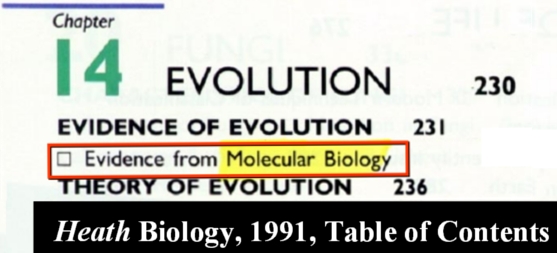
biology: the study of life
(See 'biology' The American Heritage Science Dictionary, 2002; See also The American Heritage New Dictionary of Cultural Literacy, Third Edition, 2005)
molecule: a small particle
(See 'molecule' Random House Dictionary, Random House Inc., 2010; See also American Heritage Dictionary of the English Language, Fourth Edition, 2009)
 |
All matter is made up of molecules. Salt, for example, is made up of molecules. To explain the size of a molecule, let's say you have a grain of salt, and you expand it to the size of a 1200x1200x1200 cubic feet building. The molecules contained in that grain of salt would become the size of the original grain of salt.
So when we break down the definitions, evolutionsts claim they have evidence for their theory from the study of small molecule particles of life. To understand the absurdity of this, let's look at the scientific basics of molecular biology, and what students learn in the schools. |

DNA is a biological molecule. It was co-discovered by Francis Crick in 1953, and as far as we know, the most complex molecule in the known universe. The DNA molecule contains an incredible amount of information, and that information is held within each cell in your body.
Your body contains about 50 trillion cells that are invisible to the naked eye. These tiny cells each contain a

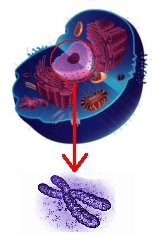 |
Inside that nucleus are Inside the chromosome is the |
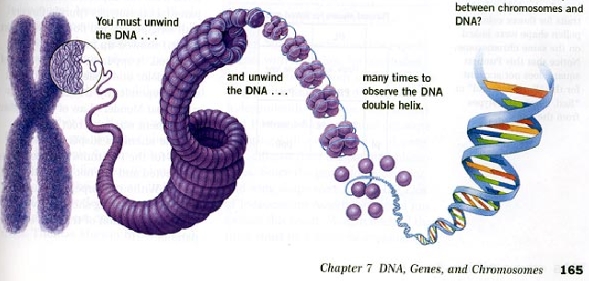
DNA is like a twisted-up ladder. Groups of the rungs of this ladder are called "genes." You get half your genes from your father, and half from your mother, which cause dominate and recessive traits.
| If you laid out the DNA strand end-to-end, it would be about 6 feet long. So how does something that long fit into a tiny cell nucleus? Take a rubber band, and begin twisting it, it will look like a twisted ladder. If you continue to twist the rubber band, it will start to clump together as it twists the twisted strand to form a "double helix," which is the shape DNA was designed to take to fit inside a cell. |  |
 |
"Human DNA is like a computer program but far, far more advanced then any software ever created." -Bill Gates, The Road Ahead, Penguin: London, Revised, 1996 p. 228; Image taken from Holt Biology, Visualizing Life, 1994, Chapter 7, p. 140, ISBN 0-03-053817-3 |
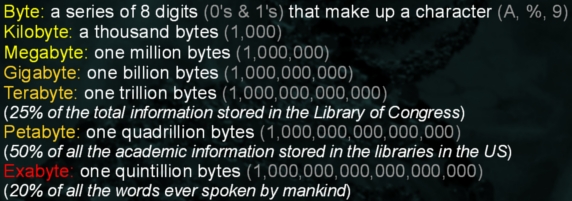
-Time Magazine, Vol. 161, Issues 2-10, Feburary 2003; See also Stephanie Watson, The Mechanisms of Genetics: An Anthology of Current Thought, Rosen Publishing Group, 2005, p. 93, ISBN: 9781404204027
Nearly inconceivable amounts of information are contained in an almost invisible amount of space. The DNA is absolutely incredible. So why is DNA, which would obviously have to be carefully and brilliantly designed, still claimed as evidence for the mindless random chance processes proposed by the evolution model?
As we read earlier, evolutionists claim they have evidence for their theory from molecular biology. To put the analogy of the cell into perspective, let's see if we can get a space shuttle to evolve on its own without any prior information input. Or, for the DNA,
Not only does this DNA code contain more information than all the computer programs written by mankind combined, but the cell in which it resides is far more complex than a space shuttle. The DNA will unwind itself, split to make a duplicate, then wind itself again to create a brand new cell. When a baby is conceived, it will produce about 15,000 new cells per minute. Imagine producing a factory that must create 15,000 brand new space shuttles, ready for take-off, per minute.
"During embryogenesis (the process by which an embryo is converted from a fertilized cell to a full-term fetus), brain cells develop at the astounding rate of over250,000 per minute . There are several points during the process of neurogenesis (the production of brain cells) where over50,000 brain cells are formed every second ."
-Kenneth A. Wesson, educational consultant in neuroscience, "Early Brain Development and Learning," retreived Dec 5, 2011, [www.sciencemaster.com]
"Even with DNA sequence data, we have no direct access to the processes of evolution, soobjective reconstruction of the vanished past can be achieved only by creative imagination. "
-N. Takahata, "A Genetic Perspective on the Origin & History of Humans," Annual Review of Ecology & Systematics, 1995
To even attempt to explain the formation of a nano-factory, with near-endless libraries of information stored inside it, by purely naturalistic means, with no intelligence behind it, defies logic and reason.
For the invisible things of him from the creation of the world are clearly seen, being understood by the things that are made, even his eternal power and Godhead; so that they are without excuse:
-Romans 1:20
Many people have heard of something called the "Human Genome Project." However, most of those people have been misled to think the human DNA has been decoded.
decode: to translate (data or a message) from a code into the original language or form; to extract meaning from
(See 'decode' Random House Dictionary, Random House Inc., 2010; See also American Heritage Dictionary of the English Language, Fourth Edition, 2009)
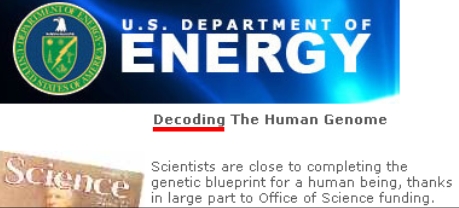

In reality, scientists have taken enourmous blocks of the DNA code, and simply given it a color code and a letter name. There are four letters: A, T, C, and G. These letters stand for four nucleic acid bases: Adenine, Thymine, Cytosine, and Guanine. T pairs with A, and G pairs with C. These are called basepairs. The human DNA contains about 3 billion basepairs. All the basepairs in all the cells in your body could fit into about two tablespoons. If you took those two tablespoons of basepairs, linked them together, and stretched them out as far as they would go, they would reach the moon and back about 5 million round trips. After labeling many of these huge blocks of microscopic code, they get a long list of letters, which is called "DNA Sequencing."
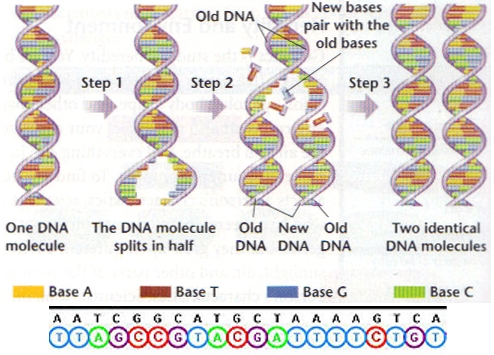
The 13 years scientists spent coloring and lettering the big blocks of the human DNA code is called the Human Genome Project. The evolutionists then sequenced a chimp's DNA, and lined up the chimp DNA next to the human DNA. They found a 95% similarity in the DNA colors and letters.
(See Roy J. Britten, "Divergence between Samples of Chimpanzee and Human DNA Sequences is 5%, Counting Intels," Proceedings of the National Academy of Sciences, 99:13633-13635, October 15, 2002; See also Brad Harrub, Ph.D & Bert Thompson, Ph.D, "Do Human and Chimpanzee DNA Indicate an Evolutionary Relationship?" Apologetics Press, 2002)
| The original claims of human-chimp DNA similarity was 98.6%. Later it was found to be 97%, and then later still 95%, as referenced above. Today, research is showing only an 86-89% similarity, depending on the criteria comparison. |
The evolutionists jumped on this, claiming DNA evidence for humans and chimps from common evolutionary ancestors. This is absurd logic.
"Even with DNA sequence data, we have no direct access to the processes of evolution, so objectivereconstruction of the vanished past can be achieved only by creative imagination. "
-Dr. N. Takahata, "A Genetic Perspective on the Origin & History of Humans," Annual Review of Ecology & Systematics, 1995
There are three major points to consider:
(For breast milk, see Encyclopaedia Britannica: Arts, Science and miscellaneous Literature, Edinburgh: Archibald Constable & Cie, 1823, pp. 752; For eyes, see Time Magazine [www.time.com], "Science: Octopus, Anyone?" Sept. 26, 1960)

"Similar structures nearly always have similar plans (DNA in this case).Similar bridges have similar blueprints. This hardly constitutes evidence that one sired the other or that they were erected by tornadoes."
-Tom Willis, "Lucy Remains at College - Dr. Donald Johanson Brings His Unique Brand of "Science" to the University of Missouri," CSA News Article

Let's not forget that each one of these colored letters in the DNA molecule is representing huge chunks heavily coded, complex information. Color coding a letter in a string of letters does not explain the complexity involved.
There are no aliens out there, (Gen 3:20) but let's say an alien visited the planet earth, and hovers his spaceship over New York City, New York. Let's say he labels four types of vehicles he sees: Airplanes, Cars, Trucks, and Golf-carts. He labels these vehicles as A, C, T, and G. He then creates a string of letters based on the the vehicles he observes in the roads.

Evolutionists have poured an enormous amount of faith into thinking that DNA will help their theory, however, molecular biology is one of the worst subjects to research if one is avoiding an intelligent designer because of the irreducibly complex systems all life is built upon.
A man and woman have a child, the child looks similar to the two parents, and due to similar factors in their facial structure, hair color, and/or medical ailments, evolutionists assert that these traits carries some evidence that the child is descended from the parents. This is the concept that many college students are taught to convince them in believing in evolutionary dogma, but there are some major logical problems about this that are not pointed out to them.
First of all, in legal court cases of a man questioned to be the father of a child, the child's facial structure, hair color, and/or medical ailments in comparison to the man accused are never used as evidence, because that argument would be dismissed on terms of coincidence. Courts of law understand that nothing is proven through similarity of appearance, and there have been a number of people in the world who have met someone who looks exactly the same as they do, but they are from different families and they have never met before.
Of course, an evolutionist will point out that DNA evidence has been used in courts of law, and this is true, but before a U.S Court will even hear DNA evidence, the CPI (Combined Parentage Index) would have to be over 100, which is a 99% similarity, and even then, it is sometimes thrown out as inconclusive. In cases of immigration in the U.S., the CPI must be over 200 to allow as evidence, and that's over a 99.5% simiilarity, which is sometimes thrown out as inconclusive.
"For example, naturally occuring mutations sometimes present more complicated results. Sometimes father and child share many common alleles and, though there are matches at all genetic systems,the CPI value is not strong enough for a conclusive result ."
-IdentiGene, "Paternity Test Results," retrieved July 23, 2014, [www.dnatesting.com]
Concerning paternity tests, DNA matching is much more accurate with three people: mother, father, and child, but in other cases, such as murder trials, it can be more difficult to prove. In order to convict someone on DNA evidence alone, CPI numbers must range in the thousands, or hundreds of thousands, creating a 99.99% or higher similarity, thus without an almost 100% exact match in comparison, DNA is not used as evidence, and is certainly not as reliable and conclusive in all situations like they make it sound on TV and movies.
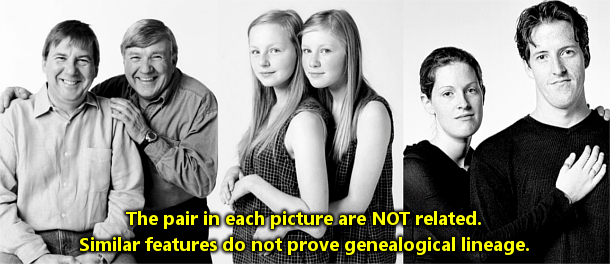
(Photos by François Brunelle in his project, "I'm Not a Look-Alike!" -- [www.francoisbrunelle.com])
The images above were taken by Canadian photographer François Brunelle, who works on a project of photographing
For example, the New England Complex Systems Institute (a big supporter of evolution) makes the following statment about evolution:
"The bodies of deer, moose, zebras, and horses arevery similar , and these animals arevery closely related ."
-NECSI, "Similarities Among Living Organisms," retrieved July 23, 2014, [http://necsi.edu/projects/evolution/evidence/living/evidence_living.html]
Despite that these animals are not all interfertile (e.g. moose and zebra), evolutionists still believe they are related in terms of biological ancestry on the grounds of similarity. But what we have already demonstrated is that similarity cannot determine biological relation, so we would then have to turn to something other than scientific inquiry.
In order to prove an evolutionary history, there would have to be an actual history! However, there is none for evolutionists. The only historical document we have to the lineage of mankind is found in the Holy Bible, which means Christians have actual evidence concerning lineage, and evolutionists have none.
At this point, they'll turn to something called "mitochondrial DNA," (mtDNA) which in mankind, is inherited only from the mother. However, what evolutionists don't admit is that there is not enough data in mtDNA to prove a lineage, and that the data pulled past 3-4 generations must be
The evolutionists are searching for a "mitochondrial Eve" that they think will prove their evolutionary model, however, in some stuudies, it's been found that mitochondrial Eve lived about 6,000 years ago:
"Regardless of the cause, evolutionists are most concerned about the effect of a faster mutation rate. For example, researchers have calculated that "mitochondrial Eve"--the woman whose mtDNA was ancestral to that in all living people—lived 100,000 to 200,000 years ago in Africa. Using the new clock,she would be a mere 6000 years old. No one thinks that's the case , but at what point should models switch from one mtDNA time zone to the other?"
-Science, "Calibrating the Mitochondrial Clock," Vol. 279, No. 5347, Jan 1998, p. 28-29, ISSN: 0036-0875 [http://www.sciencemag.org/content/279/5347/28.full]
Notice they said "no one thinks that's the case," but that is not true. The real problem is that the "no one" they're referring to are those who do not ascribe to their preconceived religious beliefs in evolution.
The real question we have to ask is: if this is a scientific experiment, why are they so quick to throw out the 6,000-year number? Why is it not even considered (as supposedly-unbiased observers) a possibility? The answer is found in whatever they're using to cross-reference their data, and that is
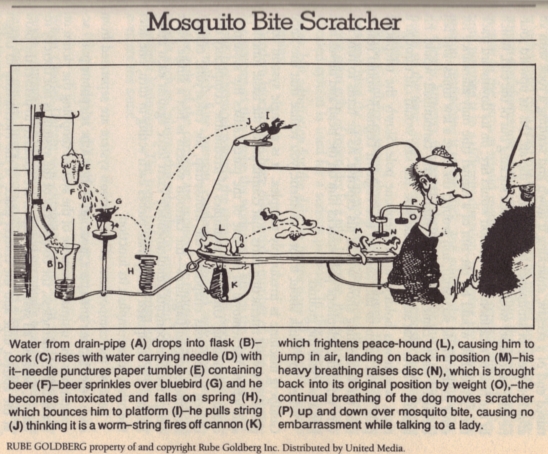
Take a close look at Rube Goldberg's Mosquito Bite Scratcher. Take a look a each of the parts, and try to determine which one of the parts of this machine can be taken away, and the machine still work.
- If you take away the water from the drain pipe, the needle cannot rise.
- If you take away the beer, the bluebird cannot become intoxicated.
- If you take away the string, the bird can't fire the cannon.
- If you take away the scratcher, the mosquito bite cannot be scratched.
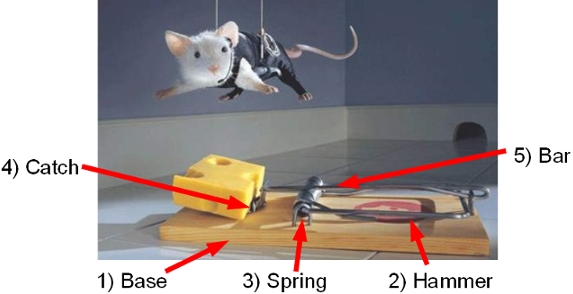
A mouse-trap contains 5 basic parts, fit together in a specific way that it performs a single function for which it is designed.
- Base: holds the trap pieces in place
- Hammer: kills the mouse when released
- Spring: extended ends to press against the platform and hammer to create tension
- Catch: a pressure-sensative plate that releases when slight pressure is applied
- Bar: connects to the catch and holds the hammer back
You may hear some evolutionists give a non-sensical answer like the following, "The wooden base can be taken away, and placed on the floor." That doesn't solve anything. The floor now becomes your base, but a base is still required or the mouse-trap cannot operate. So the only thing they did was change bases and think they've found an answer for evolution.
Evolutionists commonly alter the evidence to fit their theory, instead of altering the theory to fit the evidence as real science would require, because the intricate parts of a molecule, and the coded information in the DNA, are far too complex to be explained away by random processes.
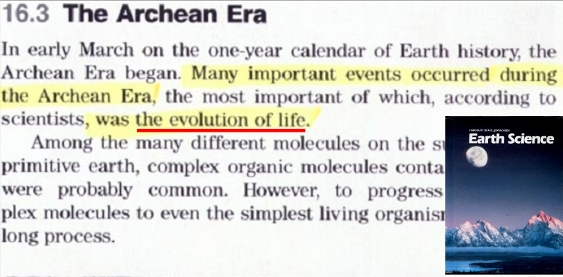
"In 1953, Stanley Miller and Harold Urey re-created the conditions of the early Earth inside two connected flasks, as illustrated [below]... The basic building blocks of life can assemble spontaneously, requiring no force more mysterious than simple chemistry."
-Holt Biology, Visualizing Life, 1994, Chapter 10, p. 200-201, ISBN 0-03-053817-3
"[The General Theory of Evolution is] the theory that all the living forms in the world have arisen from a single source which itself came from an inorganic form."
-Kerkut, G.A., Implications of Evolution, Pergamon, Oxford, UK, 1960, p. 157

-HBJ Science, 1989, p. 357
In reality, Miller and Urey, though they were trying to provide evidence for evolution by showing that life can arise from non-living material, ended up providing evidence that life cannot arise spontaneously. Washington Times named Paul Davies "the best science writer on either side of the Atlantic," and he said:
-Paul Davies, Australian Centre for Astrobiology, Macquarie University, Sydney, New Scientist, 179(2403);32 12 July, 2003
Let's take a look at the Miller-Urey experiment, and what actually happened.

As listed above, four main gases (methane, ammonia, hydrogen, and water vapor) were used in this Miller-Urey experiment to develop an "early atmosphere." How do they know those were the four gases that existed in that early atmosphere, billions of years ago? They don't know. Miller and Urey needed those four gases in order get the right mixture to create amino acids, and it is all based on the ASSUMPTION that evolution has occured and the earth is billions of years old. There is no evidence to support the methane & ammonia hypothesis.
"What is the evidence for a primitive methane-ammonia atmosphere on earth? The answer is thatthere is no evidence for it, but much against it. "
-Philip H. Abelson, "Chemical Events on the Primitive Earth," Proceedings of the National Academy of Sciences, Vol. 55 June 1966, p. 1365

They sent these gases through the tubes into an electric spark to simulate lightning. (60,000 volts, even though lightning produces many hundreds of millions of volts) Then a trap was set at the bottom to filter out anything that was created in the process. After numerous attempts, eventually, they found "red goo" in their trap that was "rich in amino acids."
Amino acids are like letters used to create a word. The experiment only yielded two amino acids (glycine & alanine). Twenty different amino acids are required for life, all linked together properly, and in the correct order. On top of that, the smallest proteins known have at least 70-100 amino acids all arranged in a particalar way that line up properly with the nucleotides of DNA. What was made was the equivalent of a few letters, when they needed an entire book.

The textbooks also don't tell the students that 98% of the substances produced from this experiment were tar and carboxylic acid. These two substances are deadly to life. The amino acids will bond faster to tar than they will to each other. The experiment is obviously a failure when the substance they made was 98% toxic to what they were trying to create.
The problem gets even worse because the trap in this experiment is totally fictitious. If the oceans were a chemical soup, there would be no trap to seperate the substance for life. All those amino acids are going to blend back into the rest of the chemicals and be destroyed.
The students are also not informed that Miller & Urey excluded oxygen from this experiment. Ozone is made from oxygen and blocks ultraviolet light (UV-light).
"Ozone is a form of oxygen. [O3] A thin layer of ozone high in the atmosphere absorbs ultraviolet radiation from the sun."
-AGS General Science, 2004, Chapter 15, p. 337, ISBN 0-7854-3647-2

(This image shows how Chlorofluorocarbons (CFCs) have the ability to break down ozone once they come in contact with ultraviolet light. Ultraviolet light is blocked from ozone, which is why so many environmentalists are worried about the ozone layer.)
|
With no oxygen, the UV-light comes through the atmosphere full force, and would break down ammonia, and that's one of the gases Miller & Urey used in their experiment.
However, if you include oxygen, the amino acids will oxidize and break down. |
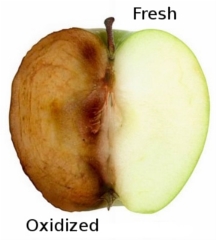 |
"In general, we find no evidence in the sedimentary destribution of carbon, sulfur, uranium, or iron, that an oxygen-free atmosphere has existed at any time during the span of geological history recorded in well preserved sedimentary rocks."
-Erich Dimroth & Michael M. Kimberley, "Precambrian Atmospheric Oxygen" Canadian Journal of Earth Sciences, Vol 13, No. 9, Sept, 1976, p 1161
I have had evolutionists ask me, "What if scientists are finally able make life in the laboratory?" I say, "Then that will prove it takes intelligence to create life." All their efforts will only prove creation and design.
"The statistical probability that organic structures , and the most precisely harmonized reactions that typify living organisms,could have been generated by accident is zero! "
-Ilya Prigogine, won the Nobel Prize in Chemistry in 1976, quoted by Shmuel Waldman, Beyond a Reasonable Doubt, Feldheim Publishers, 2005, p. 33, ISBN: 9781583308066
Evolutionists are very defensive about coming forth with the truth in public that the origin of life is a complete mystery to them, and that all scientific attempts to replicate it by natural means have failed drastically. Paul Davies gives an honest admission about why many evolutionists are uneasy to discuss what they don't know:
"There seem to be two reasons for their unease. First, they feel[underline added]it opens the door to religious fundamentalists ... Second, they worry that a frankadmission of ignorance will undermine funding, "
-Paul Davies, The Fifth Miracle: The Search for the Origin and Meaning of Life, Simon & Schuster, New York, 1999, p. 17–18
For the love of money is the root of all evil: which while some coveted after, they have erred from the faith, and pierced themselves through with many sorrows.
-1 Timothy 6:10
Knowing this first, that there shall come in the last days scoffers, walking after their own lusts, And saying, Where is the promise of his coming? for since the fathers fell asleep, all things continue as they were from the beginning of the creation. For this they willingly are ignorant of, that by the word of God the heavens were of old, and the earth standing out of the water and in the water:
-2 Peter 3:3-5
"The atheist can't find God for the same reason a thief can't find a policeman."
-Ray Comfort, "God Doesn't Believe in Atheists," 1993, p. 14
People can't find what they are not looking for, and they especially can't find what they are purposefully running from. Even for those who want to believe in a "god," many will make up a false god in their mind that suits their personal tastes, but this is called idolatry. We need to put away our desires for the lusts of this world and seek after Jesus Christ, the only one who can fill the void in our hearts.
The complexities of DNA demonstrates the character and awe of God, and according to Romans 1:20, we are without excuse to see this in the design of God's creation, and will be held accountable for refusing to seek the His Truth.
Recommended books to learn more on molecular biology:
Simon and Schuster, 2001, ISBN: 9780743214858













![There is No Saving Grace Without Repentance [creationliberty.com]](../images/store13a.jpg)
![Wolves in Costume: Kent Hovind [creationliberty.com]](../images/store11a.jpg)
![Corruptions of Christianity: Seventh-day Adventism [creationliberty.com]](../images/store09a.png)
![501c3: The Devil's Church [creationliberty.com]](../images/store07a.jpg)
![Feminism: Castrating America [creationliberty.com]](../images/store04a.jpg)







![Why Millions of Believers on Jesus Are Going to Hell [creationliberty.com]](images/store05a.jpg)
![Corruptions of Christianity: Catholicism [creationliberty.com]](http://www.creationliberty.com/images/store14a.jpg)
![False Prophet Profiles: Kim Clement [creationliberty.com]](http://www.creationliberty.com/images/store12a.jpg)
![Christmas: Rejecting Jesus [creationliberty.com]](http://www.creationliberty.com/images/store10a.jpg)
![Christian Music: For The Love of Money [creationliberty.com]](images/store08a.png)
![Psychology: Hoodwinked by the Devil [creationliberty.com]](images/store06a.jpg)
